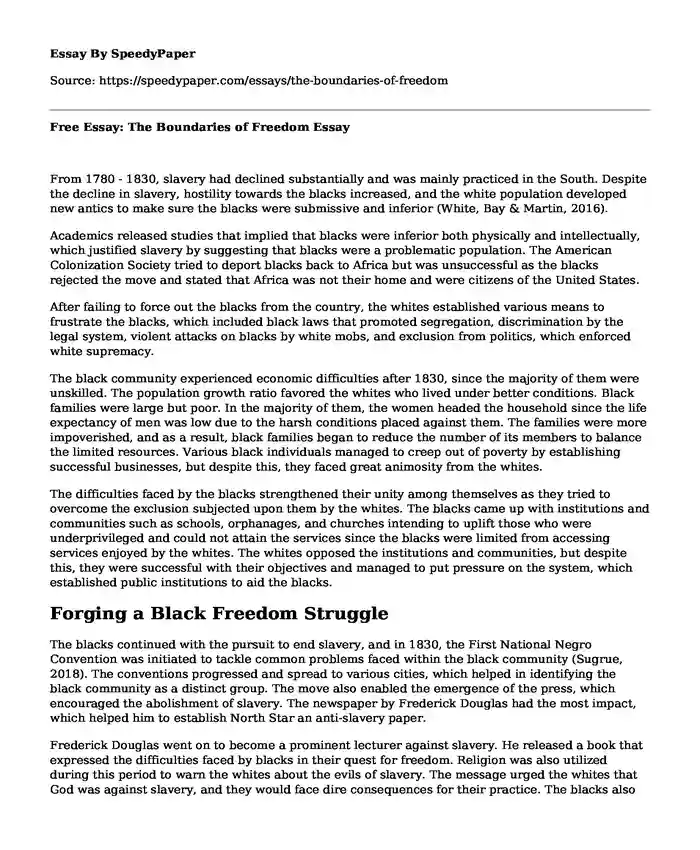
| Type of paper: | Book review |
| Categories: | Discrimination American Civil War Slavery American history |
| Pages: | 3 |
| Wordcount: | 774 words |
From 1780 - 1830, slavery had declined substantially and was mainly practiced in the South. Despite the decline in slavery, hostility towards the blacks increased, and the white population developed new antics to make sure the blacks were submissive and inferior (White, Bay & Martin, 2016).
Academics released studies that implied that blacks were inferior both physically and intellectually, which justified slavery by suggesting that blacks were a problematic population. The American Colonization Society tried to deport blacks back to Africa but was unsuccessful as the blacks rejected the move and stated that Africa was not their home and were citizens of the United States.
After failing to force out the blacks from the country, the whites established various means to frustrate the blacks, which included black laws that promoted segregation, discrimination by the legal system, violent attacks on blacks by white mobs, and exclusion from politics, which enforced white supremacy.
The black community experienced economic difficulties after 1830, since the majority of them were unskilled. The population growth ratio favored the whites who lived under better conditions. Black families were large but poor. In the majority of them, the women headed the household since the life expectancy of men was low due to the harsh conditions placed against them. The families were more impoverished, and as a result, black families began to reduce the number of its members to balance the limited resources. Various black individuals managed to creep out of poverty by establishing successful businesses, but despite this, they faced great animosity from the whites.
The difficulties faced by the blacks strengthened their unity among themselves as they tried to overcome the exclusion subjected upon them by the whites. The blacks came up with institutions and communities such as schools, orphanages, and churches intending to uplift those who were underprivileged and could not attain the services since the blacks were limited from accessing services enjoyed by the whites. The whites opposed the institutions and communities, but despite this, they were successful with their objectives and managed to put pressure on the system, which established public institutions to aid the blacks.
Forging a Black Freedom Struggle
The blacks continued with the pursuit to end slavery, and in 1830, the First National Negro Convention was initiated to tackle common problems faced within the black community (Sugrue, 2018). The conventions progressed and spread to various cities, which helped in identifying the black community as a distinct group. The move also enabled the emergence of the press, which encouraged the abolishment of slavery. The newspaper by Frederick Douglas had the most impact, which helped him to establish North Star an anti-slavery paper.
Frederick Douglas went on to become a prominent lecturer against slavery. He released a book that expressed the difficulties faced by blacks in their quest for freedom. Religion was also utilized during this period to warn the whites about the evils of slavery. The message urged the whites that God was against slavery, and they would face dire consequences for their practice. The blacks also utilized the courts to tackle exclusion by the whites that denied them from enjoying various public services.
Slavery and the Coming of the Civil War
The fugitive slave act of 1850 was very controversial and increased the tensions between Southerners who practiced slavery and Northerners who opposed slavery (Rogers, 2018). The act enabled the recapture and returning of slaves back to their masters. The law also made free slaves in the north to be targets of enslavement again. The blacks opposed the law by staging protests and petitions. The act helped the Underground Railroad to expand and increase support by white sympathizers. Harriet Tubman was at the forefront of the movement with a big bounty on her head for freeing slaves. In 1854, the Republican Party was formed as the free-soilers merged with those opposing slavery in the north. The Republican Party emerged as a viable competition against the Democratic Party, and in 1860, Abraham Lincoln of the Republican Party became the president. The win was a big step in abolishing slavery.
Summary
To counter slavery, the blacks initiated communities and institutions intending to tackle issues faced by them strategically. Conventions were held to come up with solutions, and in 1847, Fredrick Douglas launched North Star, a paper that was against slavery and attracted white readers.
References
Rodgers, J. (2018). Empire, Expansion and the Struggle for Freedom: American Political Culture at the Time of the Civil War. Xlibris Corporation.
Sugrue, T. J. (2018). The Black Freedom Struggle in the Urban North. In Oxford Research Encyclopedia of American History.White, D. G., Bay, M., & Martin Jr, W. E. (2016). Freedom on my mind: A history of African Americans, with documents. Macmillan Higher Education.
Cite this page
Free Essay: The Boundaries of Freedom. (2023, Apr 23). Retrieved from https://speedypaper.com/essays/the-boundaries-of-freedom
Request Removal
If you are the original author of this essay and no longer wish to have it published on the SpeedyPaper website, please click below to request its removal:
- Free Essay on Wendy's and McDonald's Organizational Cultures
- Free Essay on How Technology Has Enhanced Education
- Free Essay on How Hegemonic Masculinity Has Increased Violence Against Women in Bangladesh
- Earth Science Essay Sample
- Essay Example: Struggles for Individualism Against Societal Norms in The Scarlet Letter
- Book Review Essay: The Age of Extremes: A History of the World, 1914-1991
- Essay Example on Florida's Demographics
Popular categories




